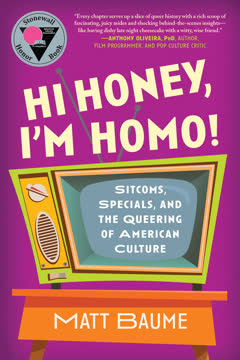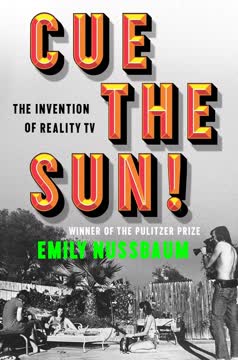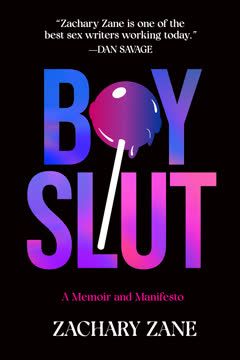Key Takeaways
1. Television's early resistance to queer representation
"For decades, Americans had held deeply entrenched beliefs that queer people were a sinister threat."
Early television censorship: In the early days of television, depictions of LGBTQ+ characters were virtually nonexistent. Censorship and societal prejudices kept queer representation off the airwaves, with any hint of homosexuality deemed inappropriate for broadcast.
Coded characters emerge: As societal attitudes slowly began to shift, some shows introduced coded queer characters. These characters, like Uncle Arthur on Bewitched, weren't explicitly identified as gay but exhibited stereotypical mannerisms that hinted at their sexuality. This allowed shows to include queer representation while maintaining plausible deniability to avoid controversy.
2. All in the Family: Breaking barriers with Beverly LaSalle
"Beverly embodies a different kind of drag, one that was far rarer at the time on TV: she is an empowered drag character."
Groundbreaking representation: All in the Family, known for tackling controversial topics, introduced Beverly LaSalle, one of television's first recurring transgender characters. Beverly's portrayal was revolutionary for its time, presenting a complex, empowered character rather than a stereotype or punchline.
Challenging societal norms: Beverly's storyline allowed the show to explore themes of acceptance, prejudice, and personal growth. Through interactions with main characters like Archie Bunker, the show challenged viewers' preconceptions about gender identity and sexuality, paving the way for more nuanced LGBTQ+ representation in the future.
3. Soap's Jodie Dallas: Pioneering gay parenthood on primetime
"Billy Crystal took a brutally difficult role, a dangerous part, a character that is the butt of jokes in this country, and made him warm and lovable and funny. Billy made Jodie Dallas someone people root for."
Controversial beginnings: Soap faced intense backlash before it even aired due to its inclusion of Jodie Dallas, one of the first gay main characters on a primetime sitcom. Despite protests and advertiser boycotts, the show persevered, allowing Jodie's character to develop over multiple seasons.
Evolving representation: Jodie's storyline evolved from initial stereotypes to tackle groundbreaking topics like gay parenthood and custody battles. This progression reflected changing societal attitudes and helped normalize the idea of LGBTQ+ individuals as parents and family members.
4. The Golden Girls: Normalizing LGBTQ+ characters and issues
"We were envious of The Simpsons. Not that The Simpsons was inherently political, but for some reason we were a remarkably political group of guys who had strong opinions. And there was a lot to react to."
Progressive storytelling: The Golden Girls consistently included LGBTQ+ characters and storylines, addressing issues like coming out, same-sex relationships, and HIV/AIDS. The show's approach was notable for its time, treating these topics with sensitivity and humor.
Impact on viewers: By presenting LGBTQ+ characters and issues as part of everyday life, The Golden Girls helped normalize queer experiences for a wide audience. The show's popularity and its stars' off-screen advocacy further contributed to increasing acceptance and understanding of LGBTQ+ individuals.
5. Ellen's coming out: A watershed moment and its aftermath
"People made a bad deal for me when it started."
Groundbreaking episode: Ellen DeGeneres's coming out on her sitcom Ellen in 1997 was a landmark moment in television history. The episode drew massive ratings and media attention, marking the first time a lead character on a primetime show came out as gay.
Backlash and cancellation: Despite initial success, Ellen faced significant backlash. The show's increased focus on LGBTQ+ issues led to declining ratings and advertiser pullouts. ABC ultimately canceled the series, highlighting the challenges still faced by queer representation on television.
- Controversial content warnings were added to episodes
- Advertisers like JCPenney and Chrysler paused their sponsorship
- The show was canceled after one more season
6. Will & Grace: Mainstreaming gay characters in primetime
"We said from the beginning, 'This probably means we probably won't be a giant hit,'"
Unexpected success: Despite initial concerns about its gay lead characters, Will & Grace became a massive hit. The show's success proved that a sitcom centered on LGBTQ+ characters could appeal to a broad audience.
Cultural impact: Will & Grace played a significant role in increasing visibility and acceptance of LGBTQ+ individuals. Its influence extended beyond entertainment, with then-Vice President Joe Biden crediting the show with educating the American public about gay rights.
- The show ran for 8 seasons initially, then was revived for 3 more
- It won 18 Emmy Awards
- Characters Will and Jack became cultural touchstones
7. Modern Family: Portraying same-sex marriage and parenthood
"For a lot of people, they might be the first gay couple that they know. We call our show the Trojan horse—we sneak into peoples' rooms and before they know they love us we're already in."
Normalizing same-sex families: Modern Family's portrayal of Mitch and Cam, a gay couple raising an adopted daughter, helped normalize same-sex parenthood for a mainstream audience. The show's popularity allowed it to tackle issues like same-sex marriage as they unfolded in real life.
Evolving representation: Over its run, Modern Family addressed criticism about its initial reluctance to show physical affection between Mitch and Cam. The show's willingness to adapt and its long-term exploration of a same-sex relationship contributed to changing attitudes about LGBTQ+ families.
- The show ran for 11 seasons from 2009 to 2020
- It won 22 Emmy Awards
- Mitch and Cam's wedding episode coincided with real-life legalization of same-sex marriage in California
8. The ongoing struggle for LGBTQ+ representation on TV
"Looking back over the last twenty years of television, it might seem as though the tug-of-war might've finally ended, that conservative activists were sufficiently exhausted by their failures, that the moral arc of the universe had finished bending, and that television was finally, safely, gay for good."
Progress and setbacks: While LGBTQ+ representation on television has increased significantly over the decades, it remains a contentious issue. Recent years have seen both unprecedented levels of queer characters and storylines, as well as renewed efforts to censor or restrict such content.
Continuing importance: The ongoing struggle for fair and diverse LGBTQ+ representation on television reflects broader societal debates about equality and acceptance. As media continues to shape public perception, the push for authentic and varied portrayals of LGBTQ+ individuals remains crucial.
- GLAAD reports increasing numbers of LGBTQ+ characters on TV
- Some states are passing laws restricting LGBTQ+ content in schools
- Streaming platforms are providing new opportunities for diverse storytelling
Last updated:
FAQ
What’s Hi Honey, I’m Homo!: Sitcoms, Specials, and the Queering of American Culture by Matt Baume about?
- History of Queer TV Representation: The book traces the evolution of LGBTQ+ representation in American sitcoms and specials, from coded subtext to explicit portrayals.
- Cultural and Political Context: Baume situates each show within its historical moment, exploring how societal attitudes and activism influenced TV and vice versa.
- Key Shows and Moments: It analyzes pivotal series like Bewitched, All in the Family, The Golden Girls, Ellen, Will & Grace, and Modern Family.
- Behind-the-Scenes Insights: The narrative includes interviews, research, and stories revealing the challenges and breakthroughs in bringing queer characters to mainstream television.
Why should I read Hi Honey, I’m Homo! by Matt Baume?
- Comprehensive Media History: The book offers a detailed, well-researched account of how sitcoms shaped and reflected public perceptions of LGBTQ+ people.
- Understanding Social Progress: Readers gain insight into the interplay between media, politics, and queer activism, learning how TV contributed to legal and cultural change.
- Entertaining and Accessible: Baume’s witty, engaging style makes complex history enjoyable, likened to “dishy late-night cheesecake with a witty, wise friend.”
- Appreciation for Sitcoms: It deepens understanding of sitcoms as both entertainment and powerful tools for social change.
What are the key takeaways from Hi Honey, I’m Homo! by Matt Baume?
- Sitcoms as Change Agents: Sitcoms used humor and family settings to introduce queer themes, making challenging ideas more accessible to mainstream audiences.
- Progress and Setbacks: Representation evolved from coded subtext to open visibility, but progress was often met with backlash and censorship.
- Impact of Visibility: TV exposure helped reduce prejudice, especially among viewers with little real-life contact with LGBTQ+ people.
- Ongoing Struggle: The book highlights a persistent tug-of-war between progress and backlash, reflecting broader societal battles over queer rights.
How does Matt Baume in Hi Honey, I’m Homo! explain the role of sitcoms in queer visibility?
- Trojan Horse Effect: Sitcoms used comedy to introduce queer themes in a palatable way, helping mainstream audiences engage with LGBTQ+ issues.
- Syndication’s Reach: Widely syndicated sitcoms brought queer representation to diverse audiences, including those outside urban centers.
- Comedy as Messaging: Baume cites Norman Lear’s idea that laughter is an “intravenous” for social messaging, making sitcoms uniquely effective.
- Incremental Progress: Sitcoms often made small steps forward, reflecting and sometimes driving broader cultural shifts.
What are some key examples of queer representation in sitcoms discussed by Matt Baume?
- Bewitched: Used witchcraft as a metaphor for the closeted queer experience, with coded subtext and queer cast members.
- All in the Family: Introduced recurring queer characters like Beverly LaSalle, tackling homophobia and acceptance.
- Soap: Featured Jodie Dallas, one of TV’s first openly gay main characters, with complex storylines about coming out and parenting.
- Barney Miller: Included one of TV’s first recurring gay couples and addressed real issues like police harassment and discrimination.
How does Hi Honey, I’m Homo! by Matt Baume describe the challenges faced by queer characters and actors in early TV sitcoms?
- Closeting and Stereotyping: Queer actors often had to hide their sexuality, and characters were reduced to stereotypes or coded roles.
- Network and Public Backlash: Shows with queer content faced protests, censorship, and sponsor withdrawals due to conservative opposition.
- Balancing Act: Creators navigated network censorship, activist demands, and public opinion, often making compromises that diluted representation.
- Personal Toll: Actors like Billy Crystal faced harassment for playing gay roles, and authentic portrayals were difficult to achieve.
What is the significance of The Golden Girls in queer representation, according to Matt Baume?
- Queer-Connected Cast: The main actresses had histories with queer projects, giving the show an authentic queer resonance.
- Chosen Family Model: The show depicted a nontraditional, chosen family, reflecting a key concept in queer culture.
- Groundbreaking Episodes: Storylines addressed coming out, HIV/AIDS, and marriage equality, fostering empathy and critical acclaim.
- Cultural Icon Status: The show became a beloved touchstone for LGBTQ+ audiences.
How did Ellen and Ellen DeGeneres’s coming out impact queer visibility, as described in Hi Honey, I’m Homo!?
- Landmark Coming Out: “The Puppy Episode” marked the first time a lead character on a network sitcom came out as lesbian, sparking national conversation.
- Industry and Social Backlash: The show faced sponsor withdrawals and network caution, reflecting ambivalence toward queer visibility in the 1990s.
- Personal Courage: Ellen DeGeneres’s activism and openness pushed boundaries despite risks to her career.
- Legacy: The show paved the way for more authentic queer representation, highlighting both progress and challenges.
What influence did Will & Grace have on public attitudes toward LGBTQ+ people, according to Matt Baume?
- Pioneering Gay Leads: The show featured openly gay main characters, normalizing queer presence in mainstream media.
- Humor and Relatability: It balanced humor with storylines about coming out and discrimination, making gay issues accessible to a broad audience.
- Political Impact: Public figures like Joe Biden credited the show with educating Americans about gay people, supported by research on reduced prejudice.
- Criticism and Balance: While sometimes criticized for stereotypes, the show struck a balance that advanced representation.
What is the significance of Modern Family in the queering of American culture, as explained by Matt Baume?
- Inclusive Family Model: The show featured a prominent gay couple raising a daughter, representing modern, diverse families on network TV.
- Relatable Storytelling: By focusing on universal parenting and family issues, the show made queer experiences accessible to mainstream viewers.
- Marriage Equality Storylines: Mitch and Cam’s wedding paralleled real-world legal progress, reinforcing acceptance.
- Genre Revitalization: The show proved that sitcoms could still innovate and influence culture in the 21st century.
What are the key concepts about queer representation in sitcoms introduced by Matt Baume in Hi Honey, I’m Homo!?
- Chosen Family: Many queer people form families of choice, a theme central to shows like The Golden Girls.
- Coding and Subtext: Early sitcoms used metaphors and coded characters to navigate censorship and societal taboos.
- Visibility and Normalization: The shift from invisibility to open representation on shows like Will & Grace and Modern Family illustrates media’s power to shape attitudes.
- Queer Characters as Plot Devices: Early on, queer characters often served as catalysts for straight characters’ growth rather than being fully realized individuals.
What are the best quotes from Hi Honey, I’m Homo! by Matt Baume and what do they mean?
- “Gay men like old ladies . . . I don’t know why.” — Betty White: Highlights the affectionate bond between The Golden Girls and their gay audience, underscoring the show’s queer icon status.
- “I’d rather be a fag than afraid.” — Jack (Will & Grace): A declaration of pride and authenticity, rejecting internalized homophobia.
- “Love is love, period.” — Blanche (The Golden Girls): A succinct, early articulation of marriage equality’s core message.
- “We have cooperated for a very long time in the maintenance of our own invisibility. And now the party is over.” — Vito Russo: Captures the book’s call to end queer invisibility in media and society, urging continued activism and representation.
Review Summary
Hi Honey, I'm Homo! traces the evolution of LGBTQ+ representation in American sitcoms from the 1960s to 2020s. Readers praised Baume's engaging writing style, historical context, and insightful analysis of how TV shows reflected and influenced societal attitudes. The book examines iconic series like Bewitched, All in the Family, and Modern Family, highlighting groundbreaking moments and behind-the-scenes struggles. While some noted a lack of diversity in the featured characters, most found the book informative, entertaining, and important for understanding the impact of media representation on LGBTQ+ acceptance.
Download PDF
Download EPUB
.epub digital book format is ideal for reading ebooks on phones, tablets, and e-readers.







